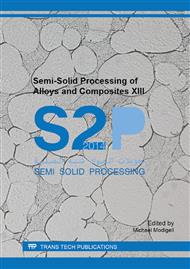p.195
p.201
p.208
p.219
p.227
p.235
p.241
p.247
p.253
Effect of the Rheocasting Process and of the SLS Layer on the Fatigue Behavior of 357 Aluminum Alloy
Abstract:
Two objectives were targeted: 1) compare the high cycle fatigue behavior of rheocast aluminum alloy 357 prepared by the swirl enthalpy equilibration device (SEED) and by the Council for Scientific and Industrial Research (CSIR) process, and 2) study the effect of surface liquid segregation (SLS) on the fatigue behavior of the CSIR material. Rectangular hourglass specimens machined from rheocast plates were tested at four stress amplitudes in axial fatigue with a stress ratio of R = -1 and a frequency of 20 Hz. Results obtained for SLS free specimens show that the SEED and the CSIR processes produce rheocast materials with comparable high cycle fatigue properties, 115 MPa at 107 cycles. In order to study the influence of surface liquid segregation, slightly polished specimens with a remaining SLS of nearly 750 microns thick were also tested. According to the results, the SLS reduces the average fatigue strength by approximately 5% (110 MPa vs. 115 MPa at 107 cycles). For SLS free specimens, the fatigue crack initiated at shrinkage cavities, oxide films or in the alpha globules. On the other hand, for specimens with SLS, no crack initiation in the alpha globules was observed. The main crack initiation mechanism was identified to be a deformation incompatibility between regions characterized by higher silicon content compared to nominal eutectic regions. The originality of the work is provided by the rigorous comparative analysis of the fatigue performance of components produced in two different rheocasting facilities, but tested in a single laboratory. It is also the first fundamental research published on the mechanical effect of surface liquid segregation. It confirms that SLS should be removed in critical areas in order to optimize the fatigue resistance of rheocast components.
Info:
Periodical:
Pages:
227-234
Citation:
Online since:
September 2014
Authors:
Price:
Сopyright:
© 2015 Trans Tech Publications Ltd. All Rights Reserved
Share:
Citation:


